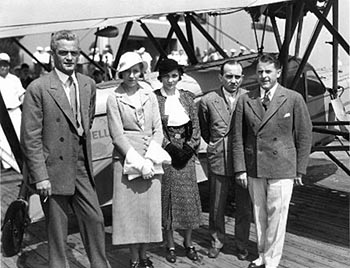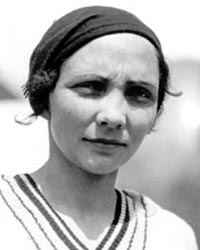
Mary 'Mae' Haizlip
Mary (May) Haizlip had her first opportunity to fly after meeting her husband-to-be, James who having returned from France after WWI was running a flying school while attending the University of Oklahoma. She took flying lessons from him and when qualified for a FAI license, had already logged 230 flying hours and was the second woman in the United States to receive her commercial pilot's license. ...more Smithsonian
Jim Haizlip, a World War I hero, was one of the more successful Wedell-Williams racing pilots. A native of Little Rock, Arkansas, he lived most of his life in Ferguson, Missouri, where he worked as an assistant manager of Shell Petroleum Company's aviation department. Under five feet tall, Jimmy was by far the slightest racing pilot of his day. After serving as a flight instructor in France during the war, he returned to Norman, Oklahoma, where he opened his own flight school and met his future wife, Mary. In 1929 he became a pilot for Safeway Airlines and the following year joined friend and fellow racer Jimmy Doolittle at Shell Oil. After modest racing success on his own, Haizlip was first contracted to fly the "92" in 1932.
 Jim and Mary Haizlip's Wedell-Williams #92
Part of the agreement between Jim Haizlip and Harry Williams was that if Jim won the Bendix, his wife, also an accomplished racer, would be allowed use of the "92" in the women's events. Although Williams was not crazy about women flying airplanes-especially his-he became Mary Haizlip's greatest fan when she set the new women's speed record at 255 miles per hour, a 45-mile-per-hour increase, a record that stood for seven years. Moreover, Mary used 100-octane fuel for this flight, the first time anyone ever used this fuel. While this sounds tame by today's standards, many observers thought that this was a foolish move and expected the plane to explode in flight. Remarkably, before the race Mary had taken only one fifteen-minute familiarization flight in the "92," an aircraft known for its instability. Competing in eight races during 1931, all in the "92," Mary finished first once and second seven times.
 Mae Haizlip at the Century of Progress Just arrived in a Shell amphibian aircraft for the Century of Progress, from left to right, Major R. G. Ervin, Mrs. Amy Johnson Mollison, Mrs. Mae Haizlip, Vernon E. Stuart and captain James G. Hazlip. download a 750pixel image
May Haizlip "Mary Haizlip had her first opportunity to fly after meeting her husband-to-be, James. He had returned from France after WWI as a senior pilot and was running a flying school while attending the University of Oklahoma. She took flying lessons from him and when she qualified for a FAI license, she had already logged 230 flying hours.
 Mae Haizlip working as a courier-driver at Douglas Aircraft in Santa Monica, California during World War II download a 500pixel image
She was also the second woman in the United States to receive her commercial pilot's license, and for seven years held the world's speed record for women. In 1930 she flew a Cessna racer, finishing second in a race and posting the fastest pylon time for the Cessna racer. In ten days at the 1931 Cleveland National Air Races, she competed in six different high performance aircraft. Haizlip was the second highest money winner, man or woman, at the 1931 National Air Races. She was also a test pilot for Spartan Aircraft, American Eagle, and Buhl Aircraft. Haizlip was the first woman pilot inducted in the Oklahoma Aviation and Space Hall of Fame on December 17, 1982."
Further reading
Williams Brothers, Inc. Wedell-Williams racer
Wedell-Williams Model 44 Racer
Wedell-Williams No. 92
1931 and 1932 Cleveland Air Race Photos
Women in Air Racing
The 1929 Air Race
|
© Copyright 1999-2002 CTIE - All Rights Reserved - Caution |
